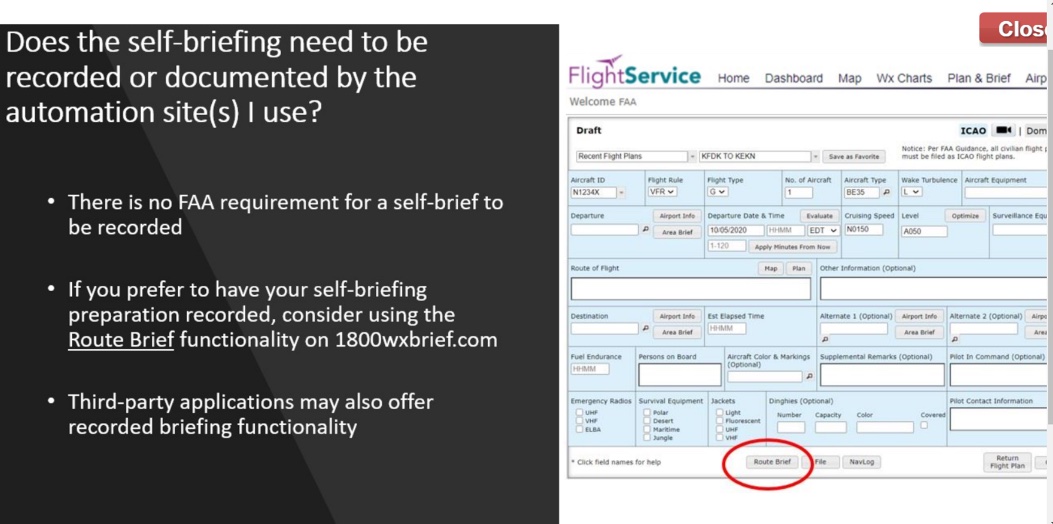|
Aug
16
2021
|
|
Posted 4 years 137 days ago ago by Admin
|
|

AUDIENCE
Round up five pilots for some hangar flying and you will undoubtedly get a mixed-bag of opinions on what exactly constitutes an official weather briefing and how one goes about getting that illustrious “official weather briefing.” No need to argue hangar professors! On 15 March 2021, Advisory Circular (AC) 91-92 was released and it is likely one that you will want to read; not only does this AC address the role and legality of online and mobile software platforms in the weather briefing process for pilots, but it also lays out a framework (checklist) of items and resources to utilize for your briefing. For icing on the proverbial cake, there is also a new online course that reviews the concepts covered in the advisory circular!
Labeled as the “Pilot’s Guide to a Preflight Briefing” its content and “advice” is very apropos as we find ourselves in an age when electronic flight bags (EFBs) are commonplace and the number of pilots who call Flight Service is dwindling.
The audience for this AC is essentially all of us! The verbiage from the AC indicates the intended audience is “all pilots, flight instructors, and operators, with emphasis on operations conducted under part 91.” Presumably, the emphasis on operations conducted under Part 91 is made because these operations typically don’t have additional resources that others have, such as aircraft dispatchers under Part 121 and operational control specialists under Part 135. Regardless, as the AC states, the content is for “all pilots” and after reading the material you will see why it is a good document to have among your EFB’s documents..
PURPOSE
The purpose of this newly released advisory circular is simple. As aptly stated in the document, “This AC provides an educational roadmap for the development and implementation of preflight self-briefings, including planning, weather interpretation, and risk identification/mitigation skills.” The goal is to provide a framework for pilots to be better prepared to interpret and utilize real-time weather information during all phases of a flight or purposed flight, including before departure, en route, and in the cockpit, for those using technology like automatic dependent surveillance-broadcast (ADS-B) coupled to third-party providers.
Thankfully, this AC may very well put the age-old debate to rest over the illustrious “official weather briefing” and what constitutes a “legal” briefing. Remember, it’s not just about weather, it’s about the entire briefing to include NOTAMS, etc. The only regulation pertaining to pre-flight briefings is § 91.103 which is the catch-all of sorts when it comes to preflight “actions”.

Specifically, § 91.103 states: “Each pilot in command shall, before beginning a flight, become familiar with all available information concerning that flight.” Fortunately, in this AC we find guidance for required preflight actions under § 91.103. Specifically, the AC states: “The FAA considers that a self-briefing may be compliant with current Federal aviation regulations.”
For those rare occasions when internet and mobile service aren’t available, don’t fret, Flight Service isn’t going away; they will still be available. The AC makes two key statements to note regarding Flight Service. Firstly: “Pilots are encouraged to utilize online automated weather resources to conduct self-briefings prior to contacting Flight Service.” And secondly:
“Pilots who have preflight weather/risk assessment and risk mitigation skills are better prepared to make in-flight decisions as real-time weather information is consumed. This allows Flight Service to become a consultative resource that can be utilized when needed.”
Note the resonating point above: “Pilots are encouraged to utilize online automated weather resources to conduct self-briefings”

In this statement a self-briefing is what is being promoted, and rightfully so considering the resources available to us today. If you are one of those that feel that contacting Flight Service is a necessity because it is “recorded,” consider that your preflight weather briefings are in fact being logged by some of your favorite aviation apps. The resources available to use in terms of self-briefing capabilities is astounding to say the least.
The authors of this document, from AFS-800 did a superb job constructing this guidance for pilots and they remind the reader of the following:
“The contents of this document do not have the force and effect of law and are not meant to bind the public in any way. This document is intended only to provide clarity to the public regarding existing requirements under the law or agency policies.”
The key phrase here is “provide clarity to the public regarding existing requirements.”
CONTENTS
In all, the AC contains 21 pages of extremely useful information for new and tenured pilots alike. The document provides several checklists for pilots to ensure their self-weather briefing is of a complete and thorough nature. There is no one-size-fits-all approach to weather related self-briefings. If you are a CFI, the use of various scenarios related to changing weather conditions can help ensure that your students truly understand the various weather related concepts at the correlative level and that they have the self-briefing skills necessary to make a competent go/no-go decision.
The AC expounds on this:
“Developing self-briefing skills helps to identify areas that require closer investigation. The more doubtful the weather, the more information you need to obtain about the route, runway conditions, and destination and alternate airports.”
If you haven’t had the opportunity to read this important advisory circular it can be found via search option on www.faa.gov - Additionally, the new online course produced by Flight Service, entitled “Conducting Preflight Self-Briefings for Student and VFR Pilots” is available on FAAsafety.gov. But don’t be fooled by the title, any pilot can get something out of both the advisory circular and the short online course, not just students and VFR Pilots. The short course is divided into seven sections and we are informed of its key purpose in the course intro section where it states: “This course was developed by Flight Service and is designed to provide the student, and visual flight rules (VFR) pilot, guidance on how to conduct a regulatory compliant preflight self-briefing using automated weather resources.”
Admittedly, at times I get a little geeked-out on weather and all of the amazing weather tools that we have at our disposal. While I certainly don’t expect most to be as engrossed with weather as I may be, this new AC and short online course can surely offer something for just about everyone.
About the Author: Matt Johnson is an FAA Designated Pilot Examiner, Part 135 Check Airman and SP-IFR Air Medical Pilot. He can be reached via email at [email protected] and via Twitter @HelicopterDPE